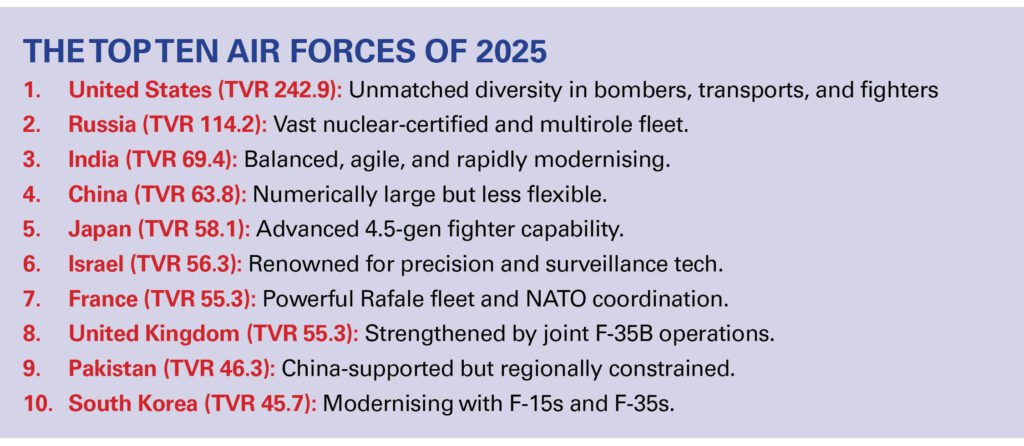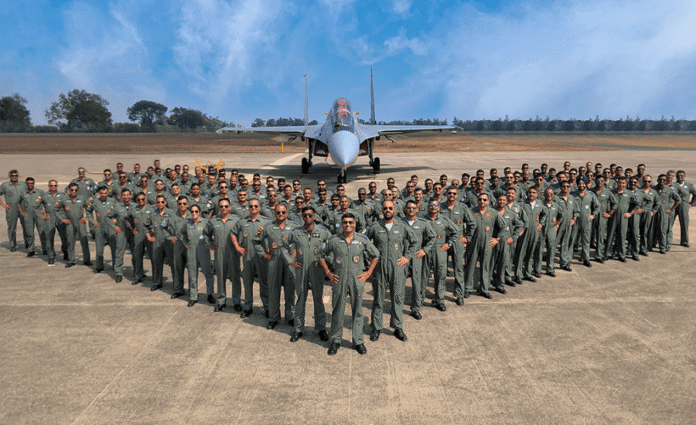In a landmark recognition that reshapes the global balance of air power, the World Directory of Modern Military Aircraft (WDMMA) has ranked the Indian Air Force (IAF) as the third most powerful air force in the world in 2025, trailing only the United States and Russia. This historic leap places India ahead of China’s People’s Liberation Army Air Force (PLAAF), marking one of the most significant strategic milestones in India’s aerial history since Independence.
A Historic Milestone in the Skies
For decades, global air power was dominated by an unshakable trio—America, Russia, and China. India’s rise into this elite group signifies not just a military upgrade but a complete redefinition of how global security analysts perceive South Asia’s strategic balance.
According to WDMMA’s 2025 Global Air Powers Ranking, the Indian Air Force achieved a True Value Rating (TVR) of 69.4, surpassing China’s 63.8, Japan’s 58.1, and Israel’s 56.3. The United States retained the top spot with a commanding 242.9, followed by Russia at 114.2.
Unlike most rankings, WDMMA’s analysis goes beyond counting aircraft. It evaluates operational readiness, modernisation, pilot skill, maintenance efficiency, and fleet balance. By that yardstick, the IAF’s rise to third place reflects its growing precision, discipline, and indigenous modernisation.
Why the Indian Air Force Surpassed China
While China boasts numerical superiority, WDMMA calls the IAF a “balanced and combat-ready aerial power.” India’s fleet composition—31.6% fighters, 29% helicopters, and 21.8% trainers—ensures readiness across offensive, defensive, and logistical operations. In contrast, China’s PLAAF, with 52.9% fighters and 28.4% trainers, suffers from a less flexible structure.
Analysts identify three major reasons behind India’s edge:
Operational Integration and Training: The IAF has invested heavily in realistic combat exercises such as Vayu Shakti, Gagan Shakti, and multinational drills like Indra Dhanush (with the UK) and Cope India (with the US). These exercises sharpened its readiness under simulated battle conditions.
Modernisation and Indigenous Production: With platforms such as the Rafale, Su-30MKI, LCA Tejas Mk1A, and advanced missile systems like Astra Mk2 and SPICE, India has blended imported technology with homegrown innovation. The Advanced Medium Combat Aircraft (AMCA) programme aims to induct India into the fifth-generation fighter club by the early 2030s.
Logistical Depth and Strategic Balance: Unlike China’s short-range sortie model, India’s air bases are strategically distributed—from Leh to Thanjavur, Gwalior, and Tezpur—offering flexibility across mountain, desert, and maritime sectors.

Building the Sky Edge: India’s Modernisation Drive
India’s leap in ranking mirrors its Aatmanirbhar Bharat vision—emphasising defence self-reliance. Over the last decade, Make in India initiatives have enabled the IAF to combine foreign systems with indigenous technology.
Key milestones include:
- Operational deployment of 36 Rafales at Ambala and Hasimara, enhancing India’s precision strike capability.
- Upgraded Su-30MKIs equipped with Indian Uttam AESA radars and locally integrated weapons.
- Expanded production of Tejas Mk1A and development of LCA Mk2 powered by GE-F414 engines.
- Ongoing AMCA stealth fighter project positioning India among next-gen air powers.
- Enhanced training and situational awareness through modern simulators and network-centric command systems.
The Strategic Impact: Asia’s New Power Triangle
For decades, global air dominance revolved around Washington, Moscow, and Beijing. Now, New Delhi has joined that circle. Unlike expansionist military models, India’s rise rests on strategic stability and defensive capability.
For decades, global air power was dominated by an unshakable trio—America, Russia, and China. India’s rise into this elite group signifies not just a military upgrade but a complete redefinition of how global security analysts perceive South Asia’s strategic balance
A study quoted by Newsweek describes India’s climb as “a transformation in regional power structures, with the IAF poised to dictate South Asian airspace dominance.” This ascent strengthens India’s deterrence along the LAC with China and the western border with Pakistan. The IAF’s rapid-mobilisation ability—evident in Operation Sindoor, a precision strike against cross-border terrorism—demonstrates tactical superiority.
Beyond Numbers: The Human Edge
While technology defines machines, people define performance. The IAF’s reputation rests on its disciplined airmen, world-class pilots, and operational ethos. With 1,700 combat aircraft and over 1,500 active pilots, India combines technological muscle with human excellence.
From the 2021 Afghanistan evacuation to Cyclone Biparjoy relief, the IAF has proven its dual humanitarian and military strength. Its advanced training academies at Dundigal and Yelahanka, coupled with participation in global exercises like Red Flag (US), Pitch Black (Australia), and Desert Flag (UAE), reinforce its status among the world’s best.
India vs. China: The Defining Rivalry
WDMMA’s assessment dismantles the notion of China’s uncontested air superiority. Despite vast spending, the PLAAF still faces training gaps and operational rigidity. India’s emphasis on pilot training, logistics, and mission readiness gives it a crucial edge.
As Moneycontrol observed, “India’s focus on pilots, logistics, and training makes it combat-effective beyond aircraft count.” China’s J-20 stealth jets and UAV programs project scale, but limited combat readiness and mission autonomy weaken their impact. India’s decentralised command structure, in contrast, enhances flexibility and quick decision-making.
While China boasts numerical superiority, WDMMA calls the IAF a “balanced and combat-ready aerial power.” India’s fleet composition—31.6% fighters, 29% helicopters, and 21.8% trainers—ensures readiness across offensive, defensive, and logistical operations. In contrast, China’s PLAAF, with 52.9% fighters and 28.4% trainers, suffers from a less flexible structure
The Global Significance
India’s third-place ranking carries deep geopolitical implications. With a defence budget exceeding $73 billion, of which 23% is dedicated to the air domain, India now spends more on aviation defence than Russia in peacetime.
For the US and Russia, India’s rise means a stable democratic partner maintaining equilibrium in Asia. For China, it signals competitive urgency. For emerging nations, India represents a model—showing how modernisation, training, and domestic production can surpass raw numbers.
The Road Ahead
Challenges remain. The IAF’s average fleet age still exceeds 20 years, with MiG-29s, Jaguars, and Mirage-2000s nearing retirement by 2035. Continued focus on fifth- and sixth-generation technology, stealth co-development, and unmanned combat integration will determine if India can hold or even surpass its third-place position in the next decade.
Yet, this achievement stands as a testament to a proud legacy—from the Gnat victories of 1965, to Kargil’s high-altitude operations in 1999, and the Balakot strike of 2019. The IAF’s evolution from a regional defender to a global power is now a reality, not an aspiration.
Conclusion
India’s recognition as the world’s third-strongest air force is more than a statistic—it is validation of decades of disciplined policymaking, technical innovation, and professional excellence.
WDMMA’s findings reaffirm that true air power is not measured by aircraft count but by training, balance, precision, and willpower.
As the tricolour soars over Ambala, Tezpur, and Thanjavur, it sends a clear message to the world: India is no longer just a regional protector—it is an aerial power of global consequence as the IAF motto proudly proclaims: Touch the Sky with Glory.
–The writer is a seasoned media professional with over three decades of experience in print, electronic, and web media. He is presently Editor of Taazakhabar News. The views expressed are of the writer and do not necessarily reflect the views of Raksha Anirveda






